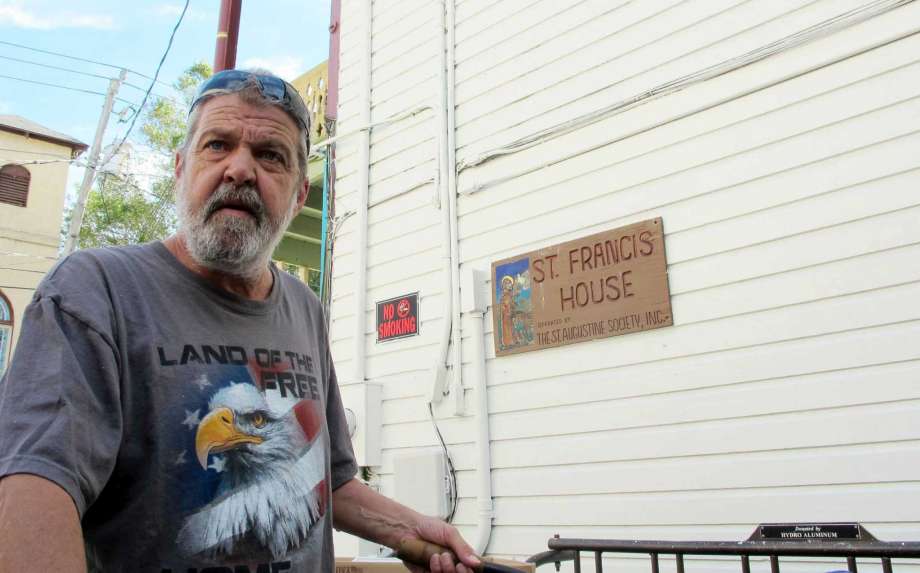
Days after Hurricane Matthew sent floodwaters surging through historic St. Augustine, the county’s director of homeless services was panicked.
County officials had ordered people to stay indoors because of evening pesticide spraying to control a post-hurricane mosquito scourge. Yet the town’s only homeless shelter was inundated with water. With the autumn air turning chilly, there was no place for homeless people to go.
“I know we’re close to Disney, but we only have so much magic,” said Kassy Guy-Johanessen, who during the spraying handed out hospital masks and water so people could wash themselves off if they were worried about being exposed.
Homes in many coastal counties in the Southeast sustained flood damage, but the loss of homeless facilities used by dozens of working poor appears to have hit this vulnerable population much harder here than in other areas. Besides the loss of shelter, the hurricane also knocked out businesses where some homeless people worked, leaving them even poorer.
The storm eliminated nearly a third of St. Johns County’s shelter capacity: 88 beds lost in the main homeless crisis center and five more when a falling tree took out a bungalow that housed a homeless family, including three children.
A few blocks from City Hall, outside the multicolored Victorian-style St. Francis House that serves as the city’s homeless crisis center, dozens of people gathered recently at a makeshift kitchen for lunch. St. Francis’s beds were always full, but now yellow caution tape was strung across the porch and handwritten signs warned people to keep out.
“Right now, we have no shelter,” said Judy Dembowski, St. Francis’ director, standing in a room with a 4-foot-high band of muck on the walls.
The county boasts the state’s second-highest median income, but before the storm, St. Augustine also had a busy homeless shelter used predominantly by people who rely on the city and county for lodging and food while working low-wage jobs in the tourist industry.
Bob Veeder, 58, lived in St. Francis House. He now sleeps outside. He said St. Francis’ staff members are his angels, giving him a bike and a sleeping bag. The sleeping bag is especially useful as it helps with the cold and protects against mosquitoes.
Veeder said losing access to the shelter has been a nightmare.
“It’s more dangerous out here with more people sleeping on the streets. I lost everything, all my stuff got stolen,” Veeder said.
St. Francis has insurance to help pay for rebuilding, but it doesn’t cover the computers, food and furniture lost in the storm, Dembowski said. It may be months before the place is habitable again.
Across town, a family of five living in a temporary transitional home managed by the Homeless Coalition was displaced when a tree busted through the roof of the small 1917-era bungalow.
Tiffany Jordan, 34, a mother of five who lives in a neighboring bungalow that was unscathed, said the loss of such housing is devastating for families on the edge of extreme poverty.
“We’d be staying in our car without this place,” she said. “This is a huge benefit in the security of having someplace safe to stay.”
Weeks after the storm, the streets here are still piled high with moldy mattresses, discarded carpets, televisions and other detritus, and some popular businesses remain closed. Without the jobs those businesses provide, some homeless people have lost income as well as shelter, said Debi Redding, executive director of the Homeless Coalition, which manages the transitional family homes.
“People are losing jobs because the businesses are flooded,” she said. At least one resident in the 18 homes she manages cannot work due to flooding. It’s unclear when businesses will reopen.
The coalition dropped insurance for the storm-damaged transitional house last year to deal with budget cuts, so Redding isn’t sure how they will rebuild it. Her staff managing the 18 transitional homes fell from nine employees to five after budget cuts, so she’s not confident rebuilding will happen anytime soon.
That means bad news not only for displaced families but those on the long waiting list for housing.
“There’s nothing more heart-breaking than telling a dad, mom and kids that we don’t have anything for them,” Redding said.
Now winter is approaching, with temperatures that can dip below freezing.
“My biggest fear is someone freezing to death because we don’t have a shelter for them,” Guy-Johanessen said.
Republished with permission of the Associated Press.



